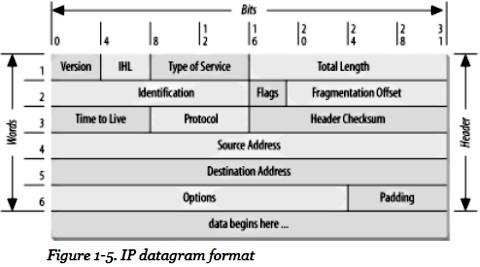The TCP/IP protocol Datagram Format
The TCP/IP protocols were built to transmit data over the ARPAnet, which was a packet-switching network.
A packet is a block of data that carries with it the information necessary to deliver it, similar to a
postal letter, which has an address written on its envelope. A packet-switching network uses the addressing
information in the packets to switch packets from one physical network to another, moving them toward their
final destination. Each packet travels the network independently of any other packet.
The datagram is the packet format defined by the Internet Protocol. Figure 1-5 is a pictorial representation
of an IP datagram. The first five or six 32-bit words of the datagram are control information called the header.
By default, the header is five words long; the sixth word is optional. Because the header's length is variable, it
includes a field called Internet Header Length (IHL) that indicates the header's length in words. The
header contains all the information necessary to deliver the packet.

The Internet Protocol delivers the datagram by checking the Destination Address in word 5 of the header.
The Destination Address is a standard 32-bit IP address that identifies the destination network and the specific
host on that network. (The format of IP addresses is explained in Chapter 2.) If the Destination Address is the
address of a host on the local network, the packet is delivered directly to the destination. If the Destination
Address is not on the local network, the packet is passed to a gateway for delivery. Gateways are devices
that switch packets between the different physical networks. Deciding which gateway to use is called routing.
IP makes the routing decision for each individual packet.
The above is an excerpt from: TCP/IP Network Administration (3rd Edition; O'Reilly Networking)



Reader G. Maxwell says,"As with all of O'Reilly's books, this one is technically accurate and fundamentally sound.
It does not teach TCP/IP from a simplistic approach - telling you only what you need to know and leaving you begging
for more. It lays a ground work based upon the actual theory of these protocols and how they were developed and the
thinking that was involved in their creation. From there, it takes you step by step through the layers of the
protocols and presents everything that most people would need to know--even more than they would need to know.
Especially enlightening were the chapters on IPv6 - the next generation of the IP protocol, and the chapter covering
subnetting. Overall, if you need the one book to explain TCP/IP and the "ins-and-outs" of these networking protocols,
look no further. This book has all you'll need.
• The ARPANET (Advanced Research Projects Agency Network) was an early implementation of a packet
switching network.
• Currently the Internet is changing form IPv4, which uses 32-bit (4-byte) addresses to IPv6 which
uses 128-bit (16-byte) addresses, so the datagram format will change. Both IPv4 and IPv6 packets have a maximum
length of 64 kB.
More Networking Protocols and Standards:
• Neighbor Discovery Protocol (NDP)
• Network Routing Protocols - IGRP, EIGRP, OSPF, ISIS, BGP
• Network Switches
• OSPF (Open Shortest Path First) Protocol
• The OSI Network Layer
• IPv6 Address Types and Scopes
• Networking and Internet Standards Organizations
• The TCP/IP protocol Datagram Format
• Wireless Standards - 802.11a 802.11b 802.11g 802.11n 802.11i Explained
• IEEE 802.11.x Wireless Standards
| 
